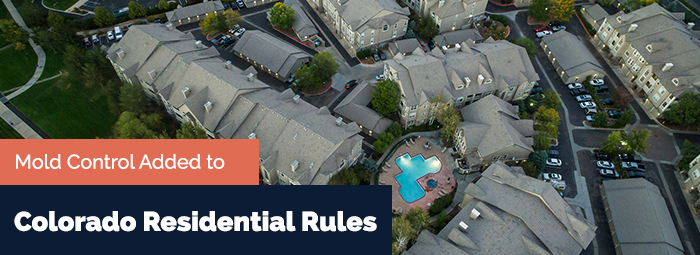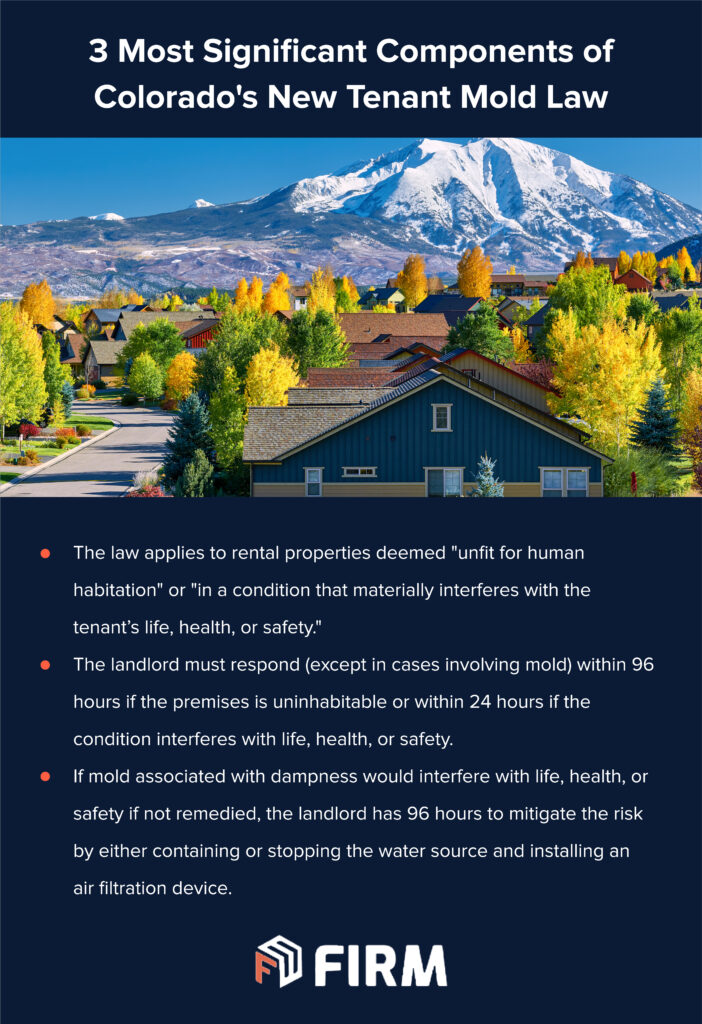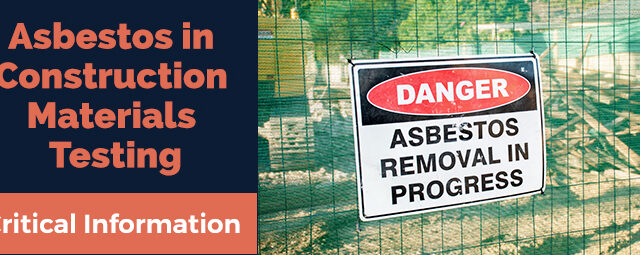
Mold Control Added to Colorado Residential Rules
Colorado law now includes mold and dampness control as a warrant of habitability requirement. That change is part of the Colorado Residential Tenants Health and Safety Act (HB 19-170). The new rule also shortens the time landlords are given to respond to tenant complaints related to the livability of residential properties.
The move immediately drew two major concerns from property managers and owners:
- How do the new warrant of habitability regulations affect the management of my Colorado residential rental properties?
- Do the new warrant of habitability regulations signal issues I should be concerned about for residential rental properties outside of Colorado?In this article, we’ll take a closer look at the bill, provide tips on how residential rental property owners and managers can stay within the requirements of the law, and point you towards a program that can keep you on the right side of this and other laws affecting multi-family property management.
An Overview of the New Warrant of Habitability Requirements
A warrant of habitability — whether stated or implied — is part of every residential rental lease. Landlords are responsible to make sure the properties they rent are fit for human occupancy during the entire period of the lease

Each state and court interprets that responsibility differently, but most would agree it includes potable water, hot water, access to electricity, bathroom facilities, access to heating, and other personal needs.
Here are three especially significant components of the new bill:
- The law applies to rental properties deemed “unfit for human habitation” or “in a condition that materially interferes with the tenant’s life, health, or safety.” That definition opens the door to innumerable types of complaints, all hinging on how the tenant feels about the housing unit (life-supporting or not, health-supporting or not, safe or not).
- The landlord must respond (except in cases involving mold) within 96 hours if the premises is uninhabitable or within 24 hours if the condition interferes with life, health, or safety. Here again, if I’m your tenant and something about the property, other than mold, is “interfering with my life,” you have 24 hours to respond.
- If mold associated with dampness would interfere with life, health, or safety if not remedied, the landlord has 96 hours to mitigate the risk by either containing or stopping the water source and installing an air filtration device. Afterwards, the landlord is granted “a reasonable amount of time” to take remedial actions that will “remove the health risk posed by mold.”
Among other requirements, the bill also directs the landlord to provide the tenant with a “comparable dwelling unit” when requested, allows the tenant to deduct rent monies under certain conditions, repeals various provisions in favor of landlords, includes the presence of functioning appliances as a requirement for habitability, and provides a pathway for injunctive relief to the tenant.
If the condition recurs within six months, and isn’t due to an appliance, the tenant can terminate the rental agreement. It should also be noted that the tenant’s notifications to the landlord can be in either written or electronic form.
(Please note we aren’t attempting to fully describe HB 19-170 here. Our aim is to pull out certain components of the bill for discussion.)
Why Does Warrant of Habitability Now Include Mold Control?
The sight of mold in a residence tends to ignite fear. And if it appears to be “black mold,” the distress can increase dramatically. This tendency doesn’t need to be backed by factual evidence or science. It’s akin to the aversion towards snakes and spiders. The presence of any mold at all is reason enough for concern, no matter the color.
Lawsuits over mold are commonplace:
A San Diego jury recently awarded a family two million dollars for the “pain, suffering, and emotional distress” they endured from mold contamination in their military privatized housing unit.
The estate of a man (who died from causes other than mold) received $250,000 in a Florida lawsuit
The City of Lewiston, Maine, is filing civil lawsuits on behalf of tenants against landlords who allow mold and other habitability issues to go unchecked.
The addition of mold control as a stated requirement under Colorado law indicates that rental property management practices there will be under tighter scrutiny and that property owners in other states should review their own mold and dampness policies.
Tips on How Property Managers Can Comply with Mold Control Requirements
Sponsors of the bill proposed the new rules as a means of “increasing tenant protections relating to the residential warrant of habitability.” That goal certainly addresses a worthwhile humanitarian purpose, but many landlords claim habitability issues — especially where mold is concerned — are most often due to neglect of the property by the occupants, not by the owners.
One landlord related the following story:
[In one case] I provided a dehumidifier and instructed tenants not to store items in the basement, but I still received complaints about mold. Upon inspection, I found the dehumidifier was unplugged and placed in a corner. There were stacks of cardboard boxes full of clothing strewn about the basement. Additionally, the tenant had removed the dryer exhaust pipe from the outside vent, so all of the humid air was circulating in the basement. Of course there was mold.
A property manager told us this:
We have an owner that just got hit with a $3,500 mold clean-up job because the previous tenant didn’t report a leaking pipe that caused the problem. It was caught at the move-out inspection. What are the chances we will recover the cost of the work from the tenant? Slim to none. Other times, we’ve seen cases where tenant neglect created the mold growth, yet they blamed it on property management and sued for “health and mental anguish” damages. It’s terrible.
We know there are landlords who neglect their duties towards tenants, but our experience at FACS is that owners want people who live in their rental units to be comfortable, safe, and pleased with the property. Heartless landlords are the exception, not the rule.
Intentions aren’t the focus, though, when you end up in court attempting to defend yourself and your company against the claim that you failed to live up to the warrant of habitability (stated or implied).


